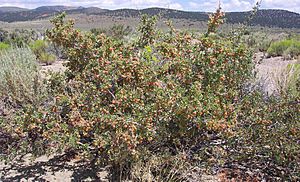Prunus andersonii facts for kids
Quick facts for kids Prunus andersonii |
|
|---|---|
 |
|
 |
|
| Conservation status | |
| Scientific classification | |
| Synonyms | |
|
The Prunus andersonii is a type of shrub often called the desert peach or desert almond. It belongs to the rose family, just like peaches, cherries, and almonds. This plant naturally grows in eastern California and western Nevada. You can find it in forests and scrub areas, especially in deserts and mountains. A scientist named Asa Gray gave it its name after Charles Lewis Anderson.
Contents
What Does Desert Peach Look Like?
The desert peach is a shrub that can grow almost two meters (about 6.5 feet) tall. Its branches often tangle together and end in sharp, spiny tips. Its leaves are shaped like spears or ovals, and they have tiny saw-like edges. These leaves grow in small groups and are usually about 3 centimeters (1.2 inches) long. The desert peach is a deciduous plant, which means it loses its leaves every year.
Flowers and Fruit
The desert peach usually has one or two flowers growing together. Each flower has about five pink petals that curve inwards. These petals are a bit less than a centimeter (0.4 inches) long. In the center of the flower, there are many thin, whisker-like stamens. The flowers bloom either before the leaves appear or at the same time.
After the flowers, a fuzzy, reddish-orange fruit grows. This fruit is a type of drupe, which means it has a hard pit inside, like a peach. It's about a centimeter (0.4 inches) wide. If there's enough rain, the fruits are juicy. But in dry years, they can be quite dry. Inside the fruit is a heart-shaped seed, which is the "stone."
How Desert Peach Grows
The desert peach can grow in two main ways. It can grow from a seed, which is called sexual reproduction. It can also grow from its rhizome, which is an underground stem. This second way is called vegetative reproduction. One desert peach plant can spread out its rhizomes and create a very large group of plants that are all genetically the same. This group is called a clone and can cover several acres!
Desert Peach and Animals
Many small animals, especially rodents, love to eat the fruits of the desert peach. They also collect and hide the seeds for later, a behavior called caching. This helps spread the seeds to new places.
Uses by Native Americans
For many years, different Native American groups have used the desert peach. The Paiute people used parts of the plant to make tea and for medicinal remedies. The Cahuilla people thought the fruit was a special treat and a delicacy.
See also
 In Spanish: Prunus andersonii para niños
In Spanish: Prunus andersonii para niños



